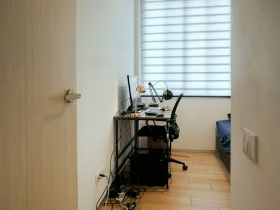Freelancing gives you freedom—but without the right setup, that freedom can quickly turn into chaos. Gone are the days when freelancers could simply perch on the couch with a laptop. In today’s digital-first world, a well-designed home office is no longer a luxury; it’s a necessity.
Your workspace directly impacts how much you get done, how well you focus, and even how balanced you feel between your professional and personal life. A cluttered corner equals a cluttered mind, while a purposeful setup can mean the difference between burnout and thriving.
In this guide, we’ll break down the core elements of a freelancer’s home office, from choosing the right desk and chair to setting boundaries with your space. You’ll also get actionable tips and resources to design a setup that supports your productivity, well-being, and career growth in 2025.
Core Elements of a Freelancer’s Home Office
1. Dedicated Workspace

One of the biggest mistakes freelancers make is blurring the line between home and work. Without a defined workspace, it’s easy to slip into distraction—scrolling social feeds, doing laundry mid-project, or letting “work mode” bleed into your evenings.
That’s why carving out a dedicated area for work is crucial. If you have an extra room, turn it into a home office. If space is tight, claim a section of your living room or bedroom and mark it as off-limits for personal use.
2. Ergonomic Furniture
Your furniture is more than just décor—it’s the foundation of your daily comfort and long-term health. Sitting for hours at the wrong desk or chair can lead to poor posture, back pain, and fatigue, all of which chip away at your productivity.
The right desk and chair don’t just look good—they keep your body supported, your posture aligned, and your workflow uninterrupted.
3. The Right Technology
Freelancers live and die by their tech. Your computer isn’t just a machine—it’s your office, your communication hub, and your paycheck rolled into one. Skimping here can cost you time, clients, and credibility.

Think of tech as your silent partner—get it right, and it will carry your freelancing career with ease.
4. Lighting and Ambience
Good lighting doesn’t just make your office look better—it directly affects your mood, energy, and eye health.
The goal is balance: enough brightness to stay sharp, but enough warmth to feel comfortable.
5. Organization Tools
Clutter is the silent productivity killer. An organized workspace is like a clear mental runway—it keeps you focused on the work, not the mess.
Think of organization as your backstage crew—it might not be visible, but it keeps the show running smoothly.
6. Software and Apps
Even the best desk and chair won’t save you if your workflow is a mess. The right apps are like having a digital assistant—keeping you organized, on time, and in control.

Smart software isn’t about adding complexity—it’s about stripping away friction so you can focus on the work that pays.
7. Well-being Extras
Your office isn’t just about output—it’s about sustaining yourself long-term. A setup that supports your health and happiness will always outperform a purely “functional” one.
Your well-being extras turn a home office from a workstation into a sanctuary.
Tailored Tips for Different Freelancers
Every freelancer’s toolkit looks a little different. Here’s how to tailor your setup to your craft:
Customizing your setup ensures your tools work as hard as you do—without compromise.
Frequently Asked Questions (FAQs)
1. What’s the most important element of a freelancer’s home office?
The most crucial element is a dedicated workspace. Having a defined area for work helps reduce distractions, improves focus, and creates a mental boundary between your professional and personal life.
2. Do I really need an ergonomic chair if I only work a few hours a day?
Yes—ergonomic chairs aren’t just for 9-to-5 workers. Even short periods of sitting can strain your back if your posture isn’t supported. An ergonomic chair protects your health long-term and keeps you more comfortable while working.
3. How fast should my internet be for freelancing?
For most freelancers, at least 200 Mbps download speed is recommended, especially if your work involves video calls, large file uploads, or cloud-based apps. A backup plan (like a hotspot) is also smart in case of outages.
4. What are the best apps to keep freelancers organized?
Popular choices include Notion and Trello for project management, Harvest for time tracking, and QuickBooks for managing invoices and finances. The right app depends on your workflow, but starting with one for tasks and one for finances is a good baseline.
5. How can I set up a home office if I have limited space?
Use modular or wall-mounted desks, foldable furniture, and smart storage like vertical shelves. Even a small corner can become an effective home office if it’s clearly defined and organized.
Conclusion
A productive home office doesn’t happen by accident—it’s the result of intentional choices. From carving out a dedicated workspace and investing in ergonomic furniture, to upgrading your tech, lighting, and organization tools, every element works together to shape how you focus and perform. Layer in the right software, well-being extras, and freelancer-specific tweaks, and you’ve got more than just a workspace—you’ve built a foundation for success.
Now it’s your turn. Take a fresh look at your current setup. What’s working? What’s holding you back? Even small upgrades—a better chair, smarter lighting, or a new app—can make a huge difference in your daily flow.
Remember, when you invest in your space, you’re not just buying furniture or gadgets—you’re investing in your freelance career. A thoughtfully designed home office pays dividends in productivity, creativity, and peace of mind.
Related links:
20 Best Ideas for a Work From Home (WFH) Office
15 Best Cabinets for a Work-from-Home (WFH)Office












Leave a Review